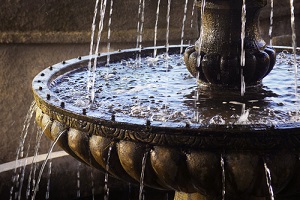 Decorative fountains can make your space more appealing and tranquil – improving the atmosphere for everyone who comes to visit. However, without proper care, a decorative fountain can quickly become a health hazard. Fountains splash water, sending water droplets into the air.
Decorative fountains can make your space more appealing and tranquil – improving the atmosphere for everyone who comes to visit. However, without proper care, a decorative fountain can quickly become a health hazard. Fountains splash water, sending water droplets into the air.
Anyone in the area can breathe in these water droplets. If the water droplets carry any harmful bacteria, they could expose a person to water-borne pathogens like Legionella – the pathogen that causes Legionnaires disease.
Here are a few strategies and pro tips that decorative fountain owners can implement to control Legionella, no matter the fountain’s size or design.
Consider the Temperature
Legionella bacteria are able to survive a wide range of temperatures, but they reproduce quickest between 77 and 108 degrees Fahrenheit. You may choose to run your fountain water a bit cold to keep Legionella dormant, but remember to factor in the influence of ambient temperatures and direct sunlight exposure. Sun-exposed fountains often warm to a temperature that is ideal for Legionella growth.
Before Sterilizing your fountain water, consider reducing temperature, which will impact the bacteria growth. Bacteria then become less likely to grow and multiply within your decorative fountain, even at room temperature. There are several methods you can use to sterilize the water, including heating the water to at least 130 degrees Fahrenheit before cooling it again.
Disinfect Surfaces
Your fountain, just like water, is another source of harmful bacteria. Even if you run sterilized water through the fountain, if the surface of the fountain itself hasn’t been cleaned or disinfected in a while, it could lead to Legionella bacteria growth. You should regularly clean and disinfect the fountain’s surfaces.
Pay special attention to the bottom of any basins, as well as nooks and crannies that may be difficult to reach. Don’t forget to clean the motor pump, too. If the pump is covered in algae or grime, it will cycle this unwanted contaminant through the entire fountain every time water passes through.
Limit Nutrient Availability
 Bacteria need nutrients to survive. If you can limit their access to nutrients by keeping your fountain and fountain water clean, you can make it harder for bacteria to thrive and reduce their bacteria’s numbers. One way to limit nutrient availability is to make regular use of an algaecide to kill bacterial matter before it can grow out of control.
Bacteria need nutrients to survive. If you can limit their access to nutrients by keeping your fountain and fountain water clean, you can make it harder for bacteria to thrive and reduce their bacteria’s numbers. One way to limit nutrient availability is to make regular use of an algaecide to kill bacterial matter before it can grow out of control.
You can also place signs around your fountain that ask visitors to refrain from putting their hands in the water or throwing dirty coins into the fountain. Coins and human hands are both ripe with organisms and nutrients that are quick to multiply and feed bacterial growth.
Run Fountains Continually
It is vital that you keep your fountain running as often as possible. This preserves the fountain’s longevity while reducing Legionella and other bacterial growth. If you start and stop your fountain’s pump motor every day, it will strain it – which could reduce the life of your fountain pump and require premature replacement. Also, not letting bacteria and other debris settle, set-up a biofilm and feed bacteria will be the benefit of constant flow.
Furthermore, it’s easier for Legionella bacteria to grow in stagnant water. If you turn off your fountain’s pump and leave it with stagnant water, which can feed on any organisms already present in the water, it could turn clean water to dangerous, infected water in a matter of days. Always keep the water moving. Ideally, turn off the fountain only to clean it. If you are unable to leave your fountain running at all hours, then at a minimum you should turn it on at least once a day.
Conduct Regular Testing
Even if you believe that you are doing everything right, it’s recommended that you test your decorative fountain’s water on a regular basis to verify that Legionella – or any other harmful bacteria – have not gained a foothold. The professionals can help you partner with a water testing lab. The testing lab will evaluate your water sample and provide thorough details about the type and amount of bacteria that the water may contain.
Equipped with this knowledge, you can develop a long-term water treatment strategy. Maybe you need to stabilize the water’s pH level or improve your control over algae growth. Or, maybe your water is not circulating as well as you anticipated. These are insights you’ll get from regular water testing.
Furthermore, if you verify via lab testing that your water does contain Legionella, you will be notified of the bacterial colonization’s density (in other words, the ratio or volume of bacteria inhabiting your water) If the number of colony-forming bacterial units exceeds 100 per mL, you’ll need to act quick to avoid a Legionella outbreak. The average concentration of Legionella bacteria associated with outbreaks is around 160 CFU/mL.
Trust the Experts to Help You Keep Your Decorative Fountain Safe
Whether you have just installed a decorative fountain and want to start your maintenance plan on the right foot, or you need help managing your existing fountain’s bacteria levels, trust the experts to help. The professionals at Tower Water would be happy to visit your fountain and create a custom plan to reduce the risk of an outbreak. Reach out to schedule an appointment or to ask any questions about your fountain’s care.
